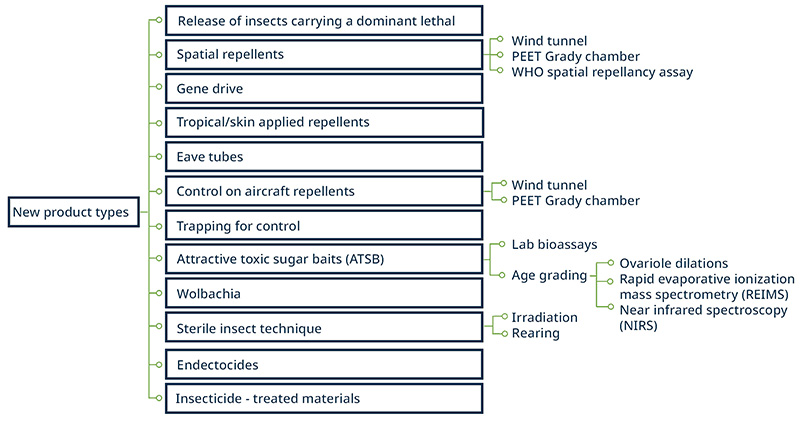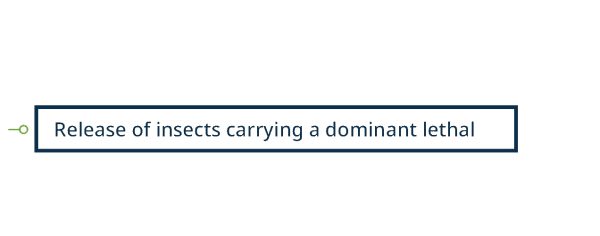New product types


Release of insects carrying dominant lethal (RIDL)
The release of insects carrying a dominant lethal (RIDL) is a genetic control method that has been proposed as a tool for mosquito control. RIDL involves genetically modifying male mosquitoes so that they carry a dominant lethal gene that is passed on to their offspring when they mate with wild females. The offspring die before they can reach maturity, which can help to reduce the overall population. RIDL requires the mass-rearing of genetically modified male mosquitoes in a laboratory and their release into the wild at regular intervals.
RIDL Resources
Spatial repellents
Spatial repellents are a type of mosquito control method that involves dispersing a repellent substance into the air to create an environment where mosquitoes are less likely to enter or bite humans. Spatial repellents can be administered through a variety of methods including sprays, candles, or diffusers. Spatial repellents can provide protection over a larger areas and do not require direct skin application.
Spatial repellent Resources
Gene drive
Gene drive is a genetic engineering technique that can be used for control of mosquito populations. It involves modifying the genes of a mosquito in a way that would make them incapable of transmitting certain mosquito-borne diseases, such as malaria or dengue. The modified genes would then be passed on to future generations at a higher rate than normal, effectively ‘driving’ the modified genes through the mosquito population.
Gene drive Resources
Topical/skin applied repellents
Topical repellents are a type of mosquito control method that involves applying a repellent substance directly to the skin to prevent mosquito bites. Topical repellents can be formulated as lotions, sprays or creams and work by interfering with the mosquito’s ability to detect and locate a human host.
Topical repellent Resources
Eave tubes
Eave tubes are a novel approach to mosquito control that involve the use of small tubes placed under the eaves of a house. These tubes are designed to attract and capture mosquitoes as they attempt to enter a house in search of a blood meal. Eave tubes work by emitting a combination of light and odour cures from within the dwelling that attract mosquitoes, which are then sucked into the tube by a fan where they become trapped in a container and eventually die.
Eave tube Resources
Control on aircraft repellents
Using mosquito repellents on aircraft is a common practice to control mosquito populations and prevent the spread of mosquito-borne diseases. Repellents can be applied to the interior of the aircraft, including seats, carpets, and curtains, as well as to the exterior of the aircraft, such as the landing gear.
Aircraft Repellents Resources
Trapping for control
Mosquito trapping is a method of control that involves the use of traps to capture and kill adult mosquitoes. There are several types of mosquito traps, including light traps, gravid traps, and carbon dioxide (CO2) traps, which use different mechanisms to attract and trap mosquitoes. Mosquito traps are typically placed in areas where mosquitoes are known to be present, such as near breeding sites, and can be used to monitor mosquito populations or as a means of reducing population numbers.
Trapping Resources
Attractive toxic sugar baits (ATSBs)
Attractive toxic sugar baits (ATSBs) are a novel approach to mosquito control that involve using a mixture of sugar and a toxic substance to attract and kill adult mosquitoes. The bait is placed in areas where mosquitoes are likely to feed, such as around homes or in mosquito breeding sites. A pesticide that is safe for humans and other non-organisms is used. When mosquitoes feed on the bait, they will ingest the toxic chemical which can cause death or other negative effects such as reduced fecundity or altered behaviour.
ATSB Resources
Wolbachia
Wolbachia is a naturally occurring bacteria that has been used as a biological control agent for mosquitoes. When introduced into a mosquito population, Wolbachia can inhibit the transmission of certain mosquito-borne diseases such as dengue, Zika virus and chikungunya. Wolbachia can be introduced into mosquito populations through a variety of methods including the release of infected mosquitoes or by infecting eggs within a laboratory.
Wolbachia Resources
Sterile insect technique
The sterile insect technique (SIT) is a method of biological control that can be used to control mosquito populations. It involves the release of a large number of sterile male mosquitoes into the environment, which mate with wild female mosquitoes but produce no viable offspring. Over time, this reduces the mosquito population. SIT requires mass-rearing and sterilisation of male mosquitoes in a laboratory, along with careful co-ordination and monitoring to ensure the sterile males are released at the right time and in the correct place.
Sterile Insect Resources
Endectocides
Endectocides are a class of insecticides that have been proposed as a potential tool for controlling mosquito populations. Unlike conventional control, endectocides not only kill adult mosquitoes, but also affect the reproductive and developmental processes of immature mosquito stages. Endectocides are typically administered as a single drug dose to humans or livestock and are ingested by mosquitoes when they take a blood meal.
Endectocide Resources
Insecticide-treated materials
The treatment of various materials, such as clothing and curtains, with insecticides is a method of vector control that can be used to either kill or repel mosquitoes. Insecticide-treated materials work by providing a physical barrier between mosquitoes and humans, as well as killing mosquitoes that come into contact with them.
Insecticide-treated material Resources